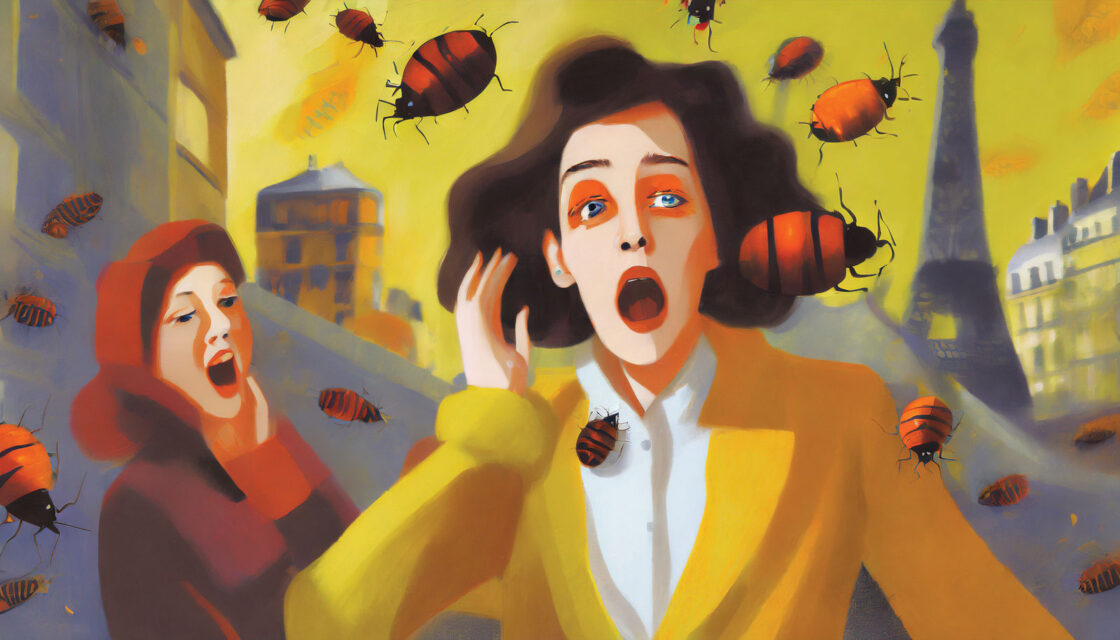Bedbugs. Just mention of the word is enough to give people the heebie-jeebies and send shivers down their spines—or start scratching. Beginning in early fall of 2023 and coinciding with Paris Fashion Week from September 25 to October 3, fear of the unhealthy vermin swept across Paris. There does not appear to be one incident that triggered the scare, but once the cry of “Bedbug!” went up, it quickly went viral online and in the Parisian media. A wave of YouTube and TikTok videos showed the proliferous pests crawling on bus seats, in trains, riding the subways, lounging at Charles de Gaulle airport, and taking in the latest plays in Paris theatre district the “Grands Boulevards.” Some anxious residents even refused to sit during their daily commutes. One British newspaper saw the humorous side of the panic, carrying the headline: “Coming Soon to a Cinema Near You? The Return of the Bud Bug.”1
Within days, the humble bedbug Cimex lectularius was being portrayed as public enemy No. 1. Politicians began holding press conferences on “the bedbug crisis” and vowing action. By September 29, the Deputy Mayor of Paris, Emmanuel Grégoire, ominously posted on X/Twitter: “No one is safe.”2 One MP, Ms. Mathilde Panot, carried a test tube filled with bedbugs into the French Parliament, complaining that pesky parasites were “making the lives of millions of our fellow citizens a living hell.”3
While they may give people the creeps, bedbugs are more of an annoyance than a major health threat. These small, reddish-brown insects have an affinity for feeding on the blood of humans as they sleep. During the day they love to hide in the cracks and crevices of headboards, box springs, mattresses, and bed frames next to their human prey, hence the name. According to the Mayo Clinic, they are not considered to be a serious health issue as they do not directly spread disease, although they can trigger allergic reactions and skin conditions, and scratching the bites can lead to infection.4
Bonne nuit. Dormez bien.
Ne laissez pas les punaises de lit piquer.
Most experts agree that there does appear to be an uptick in the bedbug population of Paris—and in many parts of the world. According to estimates from the French national pest control association, the number of calls to exterminators jumped about 10 percent over last year. However, this was not surprising as it corresponds with the spike in travel after the Covid pandemic.5 There is also evidence that bedbugs have become more resistant to insecticides while the rise in global temperatures have boosted their sex lives.6, 7 But a 10 percent increase hardly qualifies as a massive infestation.
Look closer, and all is not as it seems.
Thibault Buckley who works for a French company that specializes in dealing with bedbugs that have infested dogs, says that most of recent cases have turned out to be unrelated to bedbugs.8 The issue is also nothing new. For instance, a government survey of French households between 2017 and 2022 found that 11 percent were infested with the creepy critters.9 The French bedbug scare has also spread the fear of infestations to other European metropolitan areas. However, bedbugs have long been a feature, if a very unwanted one, of most major cities. What is new is the sudden media attention.
Soon after hearing of the bedbug infestation, Lebanese dermatologist Zeina Nehme happened to be on a trip to Paris when she decided to spend her weekend finding some of the tiny troublemakers and making a social media video about it. That’s when something odd happened: she could not locate a single bug—not in her apartment or the restaurants she visited or the vast rail network, the Paris Metro. “I actively searched to find one to take pics and do the reel. Nothing,” she said.10

This article appeared in Skeptic magazine 29.1
Buy print edition
Buy digital edition
Subscribe to print edition
Subscribe to digital edition
Download our app
The Paris bedbug “invasion” has the hallmarks of a social panic involving a real or imagined threat. In this case, the threat is real—there are bedbugs and their numbers have been increasing, but their presence has been exaggerated. Bugs are a common feature of everyday life. Now however, in the wake of sensational media reports of invading bedbugs, people have begun to scrutinize their surroundings for evidence for the critters. In the past a bus or train traveler may have sat next to one and not paid much notice. These days, Parisians are hyperaware of any bug, especially while on public transport or in public places like the cinema—and people are seeing them everywhere.
One factor likely driving the scare is misidentifications. Bedbugs are often mistaken for other insects such as cockroach nymphs, which look similar but are slightly longer and more cylindrical, and also with fleas, ticks, or carpet beetles.11 Another factor leading to the perceived invasion of bedbugs, may be embarrassment—or a lack thereof. Until recently, if someone found the creepy crawlers in their home, it was not exactly a badge of honor and they may have been reluctant to mention it to their work colleagues around the watercooler. Now, with the surge in media interest, it appears to be chic to report finding the bugs and exchange war stories with fellow Parisians. ![]()
Goodnight. Sleep tight.
Don’t let the bedbugs bite.
About the Author
Robert E. Bartholomew is an Honorary Senior Lecturer in the Department of Psychological Medicine at the University of Auckland in New Zealand. He has written numerous books on the margins of science covering UFOs, haunted houses, Bigfoot, lake monsters—all from a perspective of mainstream science. He has lived with the Malay people in Malaysia, and Aborigines in Central Australia. He is the co-author of two seminal books: Outbreak! The Encyclopedia of Extraordinary Social Behavior with Hilary Evans, and Havana Syndrome with Robert Baloh.
References
This article was published on April 26, 2024.















